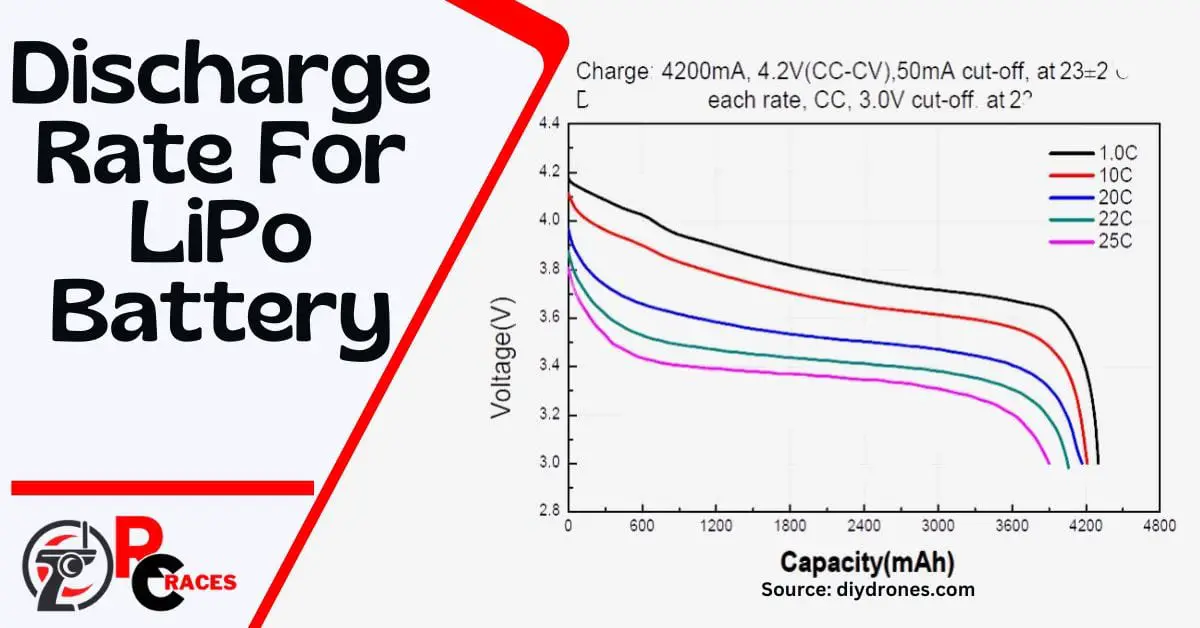Introduction
LiPo batteries are vastly used in regular electrical works nowadays. They are popular for their improved functionalities. But it’s also true that they discharge at their rate.
So, what’s the LiPo discharge rate, and how does it affect everything?
Usually, this discharge rate means the nominal range of load provided by the battery. This delivery rate can vary on different LiPo batteries. Generally, it ranges from 3.7-3.9 volts per unit of capacitance. Having a discharge rate of more than 30% of the total capacity is considered ideal.
This may still confuse you about the discharge rates of the LiPo battery. But we’re here to help so that you can get going. In this article, you’ll get to know everything from the very basics. Please have a read.
A Broader Look Into Capacity and Discharge in A Battery
The capacity of a battery simply means the maximum storage limit in the battery. It can’t hold more power than its capacity. So, if the capacity is more, the battery can be used for longer on a single charge. However, it produces heat as well.
When the battery is in use, power discharges from its total capacity. This discharging action is measured by a quantity called Ampere (A). If a battery discharges 1 Amp every hour, then it’s called 1 mAh capacitance. In other words, this is the discharge rate of that battery.
Sometimes, this discharge rate is expressed as a “C” rating. The increased number of C ratings means that the battery can be discharged faster if needed. A high discharge rate or high C-rated batteries can be used for better power delivery.
There are also terms like 3S and 4S batteries. They usually denote the number of battery cells in a series connection.
How to Calculate The Discharge Rate
LiPo batteries are rated 20C, 30C, etc. Now if a 5000 mAh battery is rated 30C, the discharge rate will be as below.
5000 mAh = 5 Ah
So, for 30C rated battery, discharge rate = 5A x 30 = 150A
This is the way you can calculate the discharge rate of a LiPo battery. Hope this won’t be difficult for you.
There are a few ways to degenerate more power from the battery. However, it is not recommended because it can cause the battery to work more than usual which may result in a battery explosion.
Some High Rated LiPo Battery List
Here we’ve included some little charts to give you an idea of battery parameters. But please note that these are not the only parameters that exist. They may vary a lot from the ones given here. These are just for your basic understanding.
20C Batteries:
| SL No. | Voltage (V) | Capacity (mAh) | Thickness (cm) | Width (cm) | Length (cm) | Discharge Rating | Burst |
| 1. | 3.7 | 500 | 0.5 | 3 | 4.8 | 20C | 40C |
| 2. | 3.7 | 500 | 0.65 | 2.5 | 4 | 20C | 40C |
| 3. | 3.7 | 500 | 0.45 | 3 | 4.8 | 20C | 40C |
| 4. | 3.2 | 1000 | 0.8 | 3.4 | 6 | 20C | 40C |
| 5. | 3.7 | 1000 | 0.6 | 3.4 | 6 | 20C | 40C |
| 6. | 3.7 | 2000 | 0.75 | 4.5 | 6.5 | 20C | 40C |
| 7. | 3.7 | 3000 | 0.64 | 4.3 | 12.5 | 20C | 40C |
| 8. | 3.7 | 4000 | 1 | 3.6 | 10.4 | 20C | 40C |
| 9. | 3.7 | 5000 | 0.9 | 4.5 | 12.5 | 20C | 40C |
| 10. | 3.7 | 10000 | 1.2 | 5.9 | 15.6 | 20C | 40C |
30C Batteries:
| SL No. | Voltage (V) | Capacity (mAh) | Thickness (cm) | Width (cm) | Length (cm) | Discharge Rating | Burst |
| 1. | 3.7 | 500 | 0.45 | 3 | 4.8 | 30C | 60C |
| 2. | 3.7 | 1600 | 0.9 | 3.4 | 6 | 30C | 60C |
| 3. | 3.2 | 2200 | 1 | 3.4 | 9.6 | 30C | 60C |
| 4. | 3.7 | 2200 | 0.78 | 3.4 | 9.6 | 30C | 60C |
| 5. | 3.2 | 3000 | 0.85 | 4.5 | 13 | 30C | 60C |
| 6. | 3.7 | 3000 | 0.6 | 4.3 | 12.5 | 30C | 60C |
| 7. | 3.7 | 4000 | 0.8 | 4.3 | 12.5 | 30C | 60C |
| 8. | 3.2 | 4500 | 0.9 | 5 | 15 | 30C | 60C |
| 9. | 3.7 | 5000 | 1 | 5 | 15 | 30C | 60C |
| 10. | 3.2 | 8000 | 0.6 | 4.5 | 13.5 | 30C | 60C |
50C Batteries:
| SL No. | Voltage (V) | Capacity (mAh) | Thickness (cm) | Width (cm) | Length (cm) | Discharge Rating | Burst |
| 1. | 3.7 | 500 | 0.5 | 3 | 4.8 | 50C | 100C |
| 2. | 3.7 | 1000 | 0.65 | 3.4 | 6.5 | 50C | 100C |
| 3. | 3.7 | 1800 | 0.9 | 3 | 8.5 | 50C | 100C |
| 4. | 3.7 | 2200 | 0.85 | 3.4 | 9.6 | 50C | 100C |
| 5. | 3.7 | 2550 | 0.55 | 4.3 | 12.5 | 50C | 100C |
| 6. | 3.7 | 3000 | 0.7 | 4.3 | 12.5 | 50C | 100C |
| 7. | 3.7 | 3500 | 0.68 | 4.5 | 14.5 | 50C | 100C |
| 8. | 3.7 | 4000 | 0.75 | 4.5 | 14.5 | 50C | 100C |
| 9. | 3.7 | 5000 | 0.85 | 5 | 15 | 50C | 100C |
| 10. | 3.7 | 6000 | 0.53 | 9 | 15 | 50C | 100C |
So, these were some of the very common battery parameters that are used. However, they may get changed in a puffed LiPo battery.
Things to Consider When Buying A Battery
A high C-rated battery circulates more power and encounters less voltage drop. That’s why they deliver better performance.
While buying batteries, you should look for better-performing batteries. But keep in mind the device requirements as well where the battery will be used. Because, connecting an overpowered or underpowered battery to your device won’t do you any good. So, choose the battery capacity and parameters that suit your device well.
Also, make sure to charge your LiPo battery well when you use it. Use good quality chargers for recharging the battery.
If you’re looking for suitable LiPo battery chargers, you can check the ones below.
| Tenergy TB-6AB Balance Charger | Check on Amazon |
| Haisito Lipo Charger HB6 | Check on Amazon |
Hope you’ll find your desired battery chargers here. Also, in case of any emergency, you should know the tricks of charging LiPo batteries without chargers.
FAQs
Is it important to know LiPo discharge rates?
Yes, it’s essential to know LiPo discharge rates. If you somehow discharge the battery at a higher rate than usual, accidents can occur. So, you can get better battery life with proper knowledge of discharge rate.
Is it recommended to fully discharge a LiPo battery?
No, it’s not recommended to fully discharge a LiPo battery. Fully discharging a LiPo battery can cause permanent damage to it. And the worst part is, the damage won’t be visible as it’s internal damage.
How long can LiPo batteries last?
A LiPo battery usually lasts from 150 to 250 cycles. Here each cycle means fully charging and discharging the battery once. However, this life expectancy can vary depending on how you use the battery. If you maintain the battery well, it will last longer.
Conclusion
So, here we are at the end of the LiPo discharge rate. Hope you got a complete overview of the concept.
Batteries are a sensitive element of electrical appliances. So, you should use and maintain the battery carefully. And use the appropriate battery always keeping the discharge rate in mind.
That’s all from us this time. Stay well and take care.


